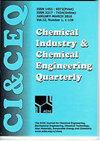Clean printing process of cotton with natural dyes: Effect of paste formulation components on printing performances
IF 0.8
4区 工程技术
Q4 CHEMISTRY, APPLIED
Chemical Industry & Chemical Engineering Quarterly
Pub Date : 2021-01-01
DOI:10.2298/ciceq191004019b
引用次数: 5
Abstract
A novel natural dye Corchorus olitorius L. was investigated in the preparation of printing pastes for screen printing of cotton fabric. To ensure ecological printing, greener thickeners were used such as: sodium alginate, carboxymethyl cellulose and Ceratonia siliqua L. flour. The nature and concentration of thickener, dyestuff and urea concentrations, mordant type and fixation method were explored. Printed cotton fabric qualities were evaluated by determining different parameters: color strength, penetration percentage, printing fastnesses and mechanical properties, whereas print paste quality was evaluated by measuring its apparent viscosity. The higher dye concentration used in the printing paste led to better apparent viscosity and color strength levels. The increase of urea concentration improved the color strength, but reduced the apparent viscosity of printing paste. Best results of viscosity and color strength parameters were obtained using ferrous sulfate as a mordant and sodium alginate as a thickener, the results being 1346.67 mPa s-1 and 4.90, respectively. The resulting color shades varied from green to brown and very good color fastnesses was achieved, but depended mainly on the used experimental conditions.天然染料棉的洁净印花工艺:浆料配方成分对印花性能的影响
研究了一种新型天然染料Corchorus olitorius L.在棉织物丝印印花浆料制备中的应用。为了保证生态印刷,使用了绿色增稠剂,如:海藻酸钠、羧甲基纤维素和白角藻粉。探讨了增稠剂的性质和浓度、染料和尿素的浓度、媒染剂的种类和固定方法。通过测定色度、渗透率、印花牢度和机械性能等参数来评价印花棉织物的质量,通过测定其表观粘度来评价印花浆料的质量。印花浆料中使用的染料浓度越高,表观粘度越高,颜色强度越高。尿素浓度的增加提高了印刷浆料的色强,但降低了印刷浆料的表观粘度。以硫酸亚铁为媒染剂,海藻酸钠为增稠剂,获得了最佳的粘度和色强参数,分别为1346.67 mPa s-1和4.90 mPa s-1。所得到的颜色深浅从绿色到棕色变化,并且获得了非常好的色牢度,但主要取决于所使用的实验条件。
本文章由计算机程序翻译,如有差异,请以英文原文为准。
求助全文
约1分钟内获得全文
求助全文
来源期刊

Chemical Industry & Chemical Engineering Quarterly
CHEMISTRY, APPLIED-ENGINEERING, CHEMICAL
CiteScore
2.10
自引率
0.00%
发文量
24
审稿时长
3.3 months
期刊介绍:
The Journal invites contributions to the following two main areas:
• Applied Chemistry dealing with the application of basic chemical sciences to industry
• Chemical Engineering dealing with the chemical and biochemical conversion of raw materials into different products as well as the design and operation of plants and equipment.
The Journal welcomes contributions focused on:
Chemical and Biochemical Engineering [...]
Process Systems Engineering[...]
Environmental Chemical and Process Engineering[...]
Materials Synthesis and Processing[...]
Food and Bioproducts Processing[...]
Process Technology[...]
 求助内容:
求助内容: 应助结果提醒方式:
应助结果提醒方式:


